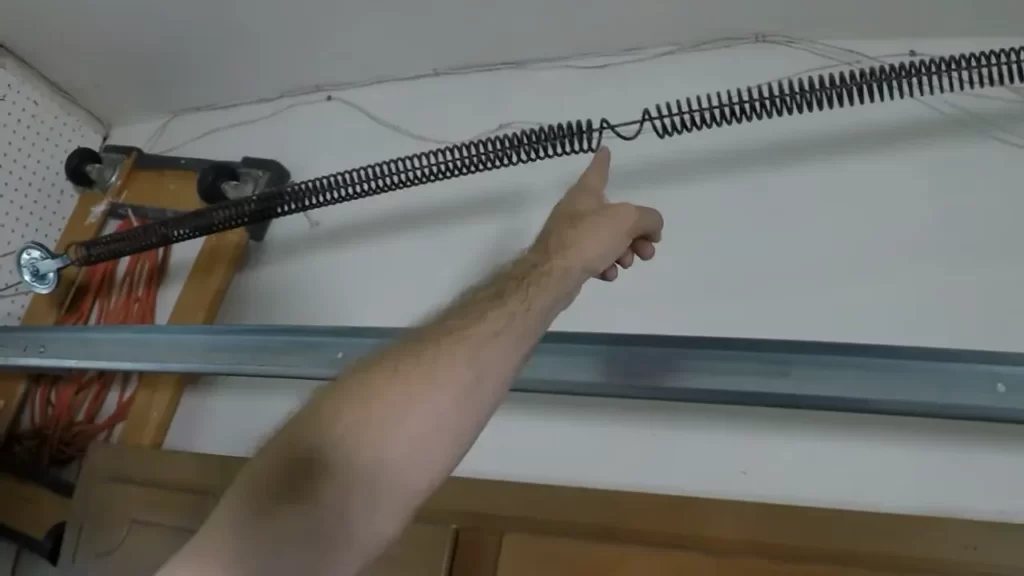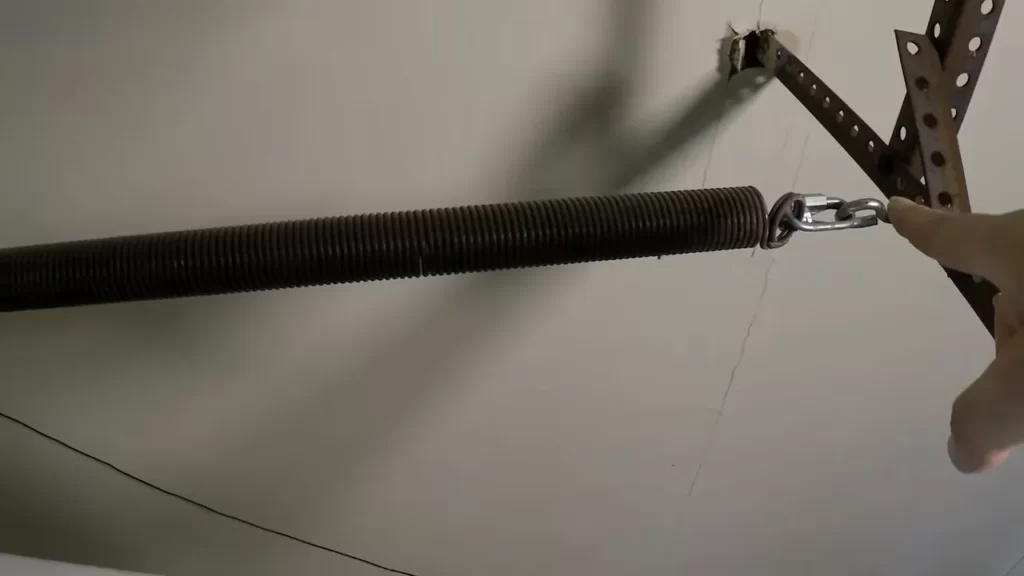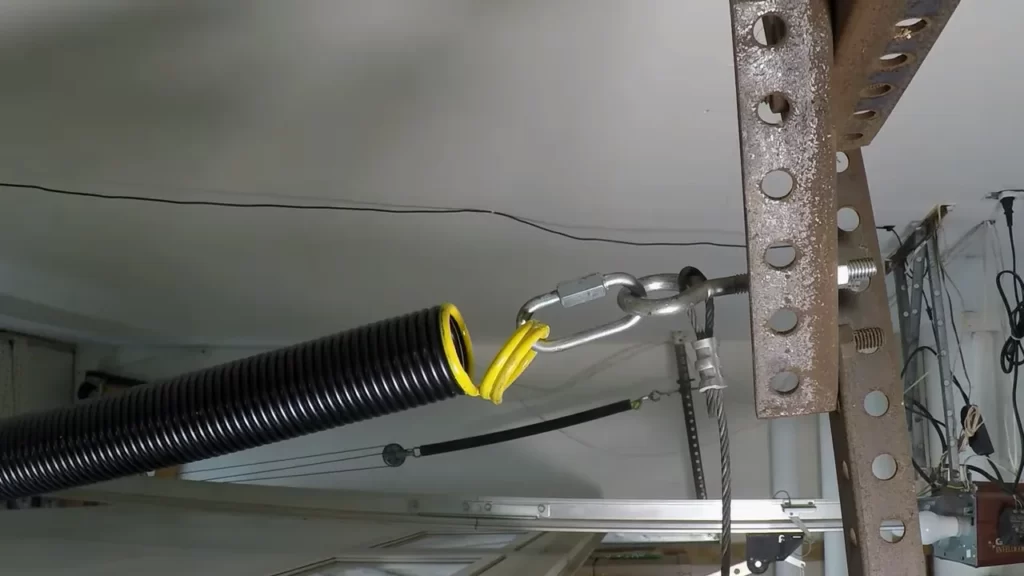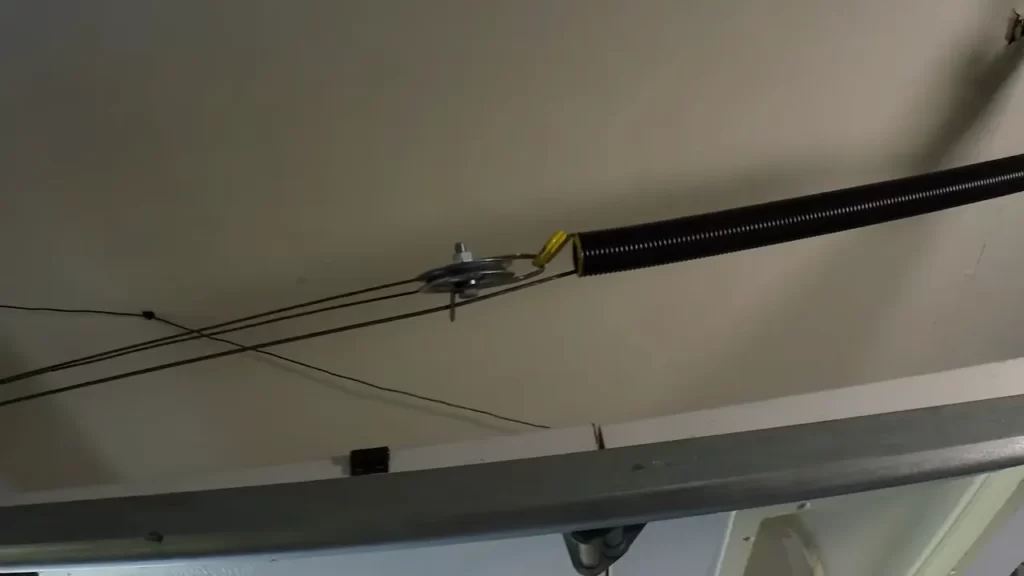To install new garage door springs, follow these steps. First, ensure you have the correct springs for your door and gather the necessary tools.
Then, disconnect the opener and release the tension from the old springs. Next, remove the old springs and install the new ones, making sure they are properly aligned and secured. Finally, test the door’s operation and make any necessary adjustments.
Introduction (120 words): Installing new garage door springs is an essential task to ensure the smooth and efficient operation of your garage door. Over time, springs can wear out or break, causing the door to become heavy and difficult to open. By following a few simple steps, you can easily replace these springs and restore your door’s functionality. It is crucial to have the correct springs for your specific door and gather the necessary tools before starting the installation process. Additionally, for safety reasons, it is important to disconnect the door opener and release tension from the old springs before removing them. This guide will walk you through the process of installing new garage door springs, ensuring a successful and hassle-free transformation.

Understanding The Importance Of Garage Door Springs
Garage door springs play a crucial role in the safe and smooth operations of your garage door. These springs are responsible for counterbalancing the weight of the door, making it easier to lift and lower. Without properly functioning springs, your garage door may become difficult to open or close, posing a safety risk and potentially damaging your door or opener. In this section, we will delve into the importance of garage door springs and discuss their role in maintaining the optimal performance of your garage door.
What are garage door springs and why are they important?
Garage door springs are tightly coiled metal components that are attached to the upper part of your garage door. They work by storing energy when the door is closed and releasing it when the door is opened. This energy transfer helps to counterbalance the weight of the door, making it easier to open or close manually, and reducing the strain on the garage door opener. You can think of garage door springs as the muscles of your garage door – they provide the necessary strength and support for the door to function properly.
The role of garage door springs in smooth and safe door operation
The primary role of garage door springs is to ensure the smooth and safe operation of your garage door. By counterbalancing the weight of the door, springs make it easier to open or close manually, preventing undue strain on your muscles and joints. Moreover, well-functioning springs also alleviate the load placed on the garage door opener, extending its lifespan and reducing the risk of malfunctions. It’s important to regularly inspect and maintain your garage door springs to ensure they are in good condition, as a faulty or broken spring can cause the door to slam shut unexpectedly or become difficult to operate, posing safety hazards for you and your family.
Signs that indicate it’s time to replace your garage door springs
Over time, garage door springs can wear out due to regular use and exposure to the elements. It’s essential to be aware of the signs that indicate it’s time to replace your springs to prevent unexpected failures and avoid potential accidents. Here are some indicators that your garage door springs may need to be replaced:
- Visible signs of wear and tear, such as rust, gaps between coils, or loose parts
- The door becomes difficult to open or close, requiring more effort than usual
- The door starts to sag or appears unbalanced when opening or closing
- Loud noises or creaking sounds coming from the garage door springs
If you notice any of these signs, it’s crucial to address the issue promptly. Contact a professional garage door technician to assess the condition of your springs and replace them if necessary. Ignoring the signs can lead to further damage to your garage door and compromise the safety of your garage space.
Gathering The Necessary Tools And Materials
Before you embark on the task of installing new garage door springs, it is essential to gather all the necessary tools and materials. Having everything you need readily available can save you time and frustration during the installation process. In this section, we will provide you with a detailed list of the tools required, the essential safety equipment to wear, and where to purchase high-quality garage door springs.
List of tools required for installing new garage door springs
Here are the tools you will need to successfully install new garage door springs:
| Tools |
|---|
| Safety goggles |
| Protective gloves |
| Tape measure |
| Adjustable wrench |
| Socket wrench set |
| Vise grips |
| Stepladder |
| Level |
| Clamps |
| Power drill |
| Drill bits |
| Hammer |
| Phillips and flathead screwdrivers |
| Wire cutters |
| Extension ladder |
Essential safety equipment to wear during the installation

process
Ensuring your safety is of paramount importance when installing new garage door springs. Here is the essential safety equipment you should wear:
- Safety goggles to protect your eyes from flying debris
- Protective gloves to safeguard your hands from cuts and bruises
Where to purchase high-quality garage door springs
When it comes to purchasing garage door springs, it is crucial to ensure their quality and durability. Here are a few reputable places where you can find high-quality garage door springs:
- Local hardware stores
- Garage door manufacturers
- Online retailers specializing in garage door parts
By purchasing from trusted sources, you can have peace of mind knowing that your new garage door springs are crafted to withstand the test of time.
Step-By-Step Guide To Installing New Garage Door Springs
Installing new garage door springs may seem like a daunting task, but with the right knowledge and tools, it can be done easily and safely. By following this step-by-step guide, you’ll be able to replace your old garage door springs and ensure your garage door operates smoothly and securely.
Safety Precautions before Starting the Installation Process
Prior to beginning the installation process, it’s crucial to prioritize safety measures. Working with garage door springs can be hazardous, so taking the necessary precautions is essential. Here are some safety tips to keep in mind:
- Ensure you have the right tools for the job, including safety glasses, gloves, and a sturdy ladder.
- Disconnect the power to the garage door opener to prevent accidental activation.
- Always work with a partner to assist you and provide additional safety.
How to Release Tension from the Old Garage Door Springs
Before removing the old springs, it’s crucial to release tension to avoid any accidents or injuries. Follow these steps to safely release tension:
- Using a winding bar, insert it into one of the winding cones securely.
- Turn the winding bar in the opposite direction of the spring’s tension until it’s fully unwound.
- Repeat this process for the second winding cone.
- Once both winding cones are unwound, slowly release the tension by letting the bar loosen and slide out of the winding cone.
Removing the Old Springs and Preparing for New Installation
Now that the tension has been released, you can proceed with removing the old garage door springs and preparing for the new installation. Here’s what you need to do:
- Use a socket wrench to loosen and remove the bolts securing the ends of the springs to the door frame.
- Detach the old springs from the door frame and carefully set them aside.
- Clean the area where the new springs will be installed, removing any debris or dirt.
Installing the New Garage Door Springs Correctly and Securely

Now it’s time to install the new garage door springs. Make sure to follow these steps for a proper and secure installation:
- Slide the new springs onto the door frame, aligning them with the necessary bolts and brackets.
- Attach the new springs to the door frame using a socket wrench, ensuring they are securely fastened.
- Double-check that the springs are properly aligned and balanced to ensure optimal performance.
Adjusting the Tension of the New Springs for Optimal Performance
After the new springs are correctly installed, it’s important to adjust their tension for optimal performance. Follow these steps:
- Using a winding bar, insert it into one of the winding cones securely.
- Turn the winding bar in the direction that corresponds to the door’s spring size and weight.
- Gradually increase the tension until the door feels balanced and operates smoothly.
- Repeat this process for the second winding cone, adjusting as necessary.
Testing the Functionality of the Newly Installed Garage Door Springs
Once you have adjusted the tension of the new springs, it’s crucial to test the functionality of the garage door to ensure everything is working correctly. Perform the following steps:
- Reconnect the power to the garage door opener.
- Test the door by opening and closing it multiple times to ensure it operates smoothly and without any issues.
- If you encounter any problems or unusual noises, double-check the installation and adjustments.
- Make any necessary adjustments to the springs or consult a professional for further assistance.
By following this step-by-step guide and taking the necessary safety precautions, you can successfully install new garage door springs and enjoy a properly functioning garage door. Remember to always prioritize safety and seek professional help if needed.
Troubleshooting Common Issues During Installation
Installing new garage door springs can be a challenging task, especially when it comes to troubleshooting common issues that may arise during the process. However, with the right knowledge and approach, these challenges can be overcome seamlessly. In this section, we will discuss the most common issues that you may encounter during the installation of new garage door springs, and the steps you can take to address them effectively.
Overcoming challenges when removing the old springs
Removing the old springs is the first step in installing new ones, and it can pose some challenges. Here are some common issues you may face:
- The springs are rusted or stuck: Over time, springs can accumulate rust or become stuck due to lack of maintenance. In such cases, it is important to ensure your safety by taking necessary precautions, such as wearing protective gloves and eyewear. Applying a penetrating lubricant can help loosen the rusted parts, making it easier to remove the old springs.
- The springs are under tension: Garage door springs are tightly wound and carry a significant amount of tension. Before attempting to remove them, you must release the tension in a controlled manner to prevent accidents. Using winding bars, carefully unwind the springs by turning them in the opposite direction of their winding. Take note of the number of turns you make to maintain the same tension when installing the new springs.
By following these steps, you can successfully remove the old springs and prepare for the installation of new ones.
Dealing with misalignment or improper tension of the new

springs
Installing new garage door springs can sometimes result in misalignment or improper tension, which can affect the smooth operation of your garage door. Here’s how you can address these issues:
- Misalignment: If the new springs are not aligned properly, it can cause the garage door to be uneven or to move unevenly. To correct this, carefully realign the springs by loosening the mounting brackets, adjusting their position, and tightening them securely. Double-check the alignment by manually operating the garage door a few times to ensure it moves smoothly and evenly.
- Improper tension: Incorrect tension can lead to various problems, such as the door not opening or closing fully, appearing unbalanced, or making excessive noise during operation. To adjust the tension, use the winding bars to turn the springs in the appropriate direction, increasing or decreasing the number of turns until the desired tension is achieved. Remember to maintain the same number of turns on both springs for balanced operation.
By properly aligning and adjusting the tension of the new springs, you can ensure optimal performance and longevity of your garage door.
Addressing any unexpected issues or complications during installation
Sometimes, unexpected issues or complications may arise during the installation of new garage door springs. Here’s how you can address them:
| Issue | Solution |
|---|---|
| The springs are the wrong size | Contact the manufacturer or supplier to obtain the correct size springs for your specific garage door model. Avoid using springs that do not match the specifications provided by the manufacturer. |
| The garage door is not balanced | If the door does not stay in place when partially opened or tends to slam shut on its own, it indicates an imbalance. Adjust the tension on the springs accordingly, making sure both sides have the same tension to achieve proper balance. |
| Unusual noises or jerky movements | If your garage door makes grinding or squeaking noises or exhibits jerky movements, it may be due to worn-out or damaged parts other than the springs. Inspect and replace any worn-out components, such as rollers, hinges, or cables, to ensure smooth and noise-free operation. |
By addressing any unexpected issues or complications promptly, you can complete the installation of new garage door springs successfully and enjoy a well-functioning door.
Installing new garage door springs is not without its challenges, but by troubleshooting common issues like removing old springs, dealing with misalignment or improper tension, and addressing unexpected complications, you can ensure a smooth and hassle-free installation process. Remember to prioritize your safety and consult a professional if you’re unsure of any aspect of the installation.
Regular Maintenance And Safety Tips For Garage Door Springs
Regular maintenance and proper safety precautions are essential for ensuring the smooth and safe operation of your garage door springs. By inspecting and maintaining your springs regularly, following best practices, and implementing safety tips, you can significantly prolong the lifespan of your springs and prevent potential accidents. In this section, we’ll discuss how to inspect and maintain your garage door springs, best practices for ensuring their longevity, and important safety tips to follow when working with them.
How to inspect and maintain your garage door springs
To keep your garage door springs in good condition, regular inspections and maintenance are vital. Follow these steps:
- Start by visually inspecting the springs for any signs of wear and tear, such as rust, cracks, or gaps. If you notice any damage, it’s crucial to replace the springs immediately.
- Next, check the tension of the springs. Disconnect the power to the garage door opener and manually open the door halfway. If the door stays in place, the springs are properly balanced. If the door moves up or down, the springs may require adjustment or replacement.
- Lubricate the springs every few months to reduce friction and ensure smoother operation. Use a silicone-based lubricant and apply a thin, even coat to the springs.
- Inspect the cables and pulleys connected to the springs for any signs of fraying or damage. Replace them if necessary.
Best practices for ensuring the longevity of your new springs

Once you’ve installed new garage door springs, follow these best practices to extend their lifespan:
- Ensure the springs are correctly installed according to the manufacturer’s instructions. Improper installation can lead to premature wear and failure.
- Avoid overloading your garage door. Excessive weight can put strain on the springs and shorten their lifespan. If you need to store heavy items, consider using a separate storage area.
- Inspect and maintain other components of the garage door system, such as the tracks, rollers, and hinges, to prevent undue stress on the springs.
- Regularly clean the springs to remove dirt and debris that can affect their performance. Use a soft brush or cloth to gently wipe away any buildup.
Safety tips to follow when working with garage door springs
Working with garage door springs can be dangerous if proper safety precautions are not followed. Keep yourself safe by adhering to these safety tips:
- Always disconnect the power to the garage door opener before performing any maintenance or repair tasks involving the springs.
- Wear safety goggles and gloves to protect yourself from potential flying debris or accidental contact with the springs.
- Never attempt to repair or replace the springs yourself unless you have the necessary knowledge and experience. It’s best to hire a professional garage door technician for complex spring-related tasks.
- When testing the tension of the springs, always stand clear of the door to avoid injury in case of a sudden snap or release.
- If you notice any unusual noises, jerking movements, or difficulties with the garage door’s operation, immediately contact a professional for inspection and possible repairs.
By following these regular maintenance steps and safety tips, you can ensure the smooth and safe operation of your garage door springs for years to come. Remember, always prioritize safety and seek professional help when needed to avoid accidents and injuries.
Frequently Asked Questions Of How To Install New Garage Door Springs
Is It Hard To Replace Garage Door Springs Yourself?
Replacing garage door springs yourself can be challenging and dangerous. It requires expertise and knowledge of proper techniques. It’s best to hire a professional to ensure the task is done correctly and safely.
How Do You Adjust The Tension On A Garage Door Spring?
To adjust the tension on a garage door spring, follow these steps: 1) Locate the adjustment screws on the torsion spring shaft. 2) Use a winding bar to turn the adjustment screws clockwise to increase tension or counterclockwise to reduce tension.
3) Test the door’s balance after each adjustment.
How Do I Know Which Way My Garage Door Spring Goes?
To determine which way your garage door spring goes, examine the coils. Typically, the spring will have a larger coil at one end and a smaller coil at the other. The larger coil should be at the bottom, while the smaller coil should be at the top.
It is important to consult a professional if you are unsure.
What Happens If You Put The Wrong Spring On A Garage Door?
Putting the wrong spring on a garage door can lead to several problems. It can cause the door to not function properly, become unbalanced, or even be unsafe. It may also lead to excessive wear and tear on other components of the door.
It is crucial to choose the correct spring based on the door’s specifications and weight to ensure proper functioning and safety.
Conclusion
To sum up, installing new garage door springs can be a challenging task, but with the right tools and knowledge, it can be done efficiently. By following the steps outlined in this guide, you can ensure the safety and functionality of your garage door.
Remember to prioritize caution and consider seeking professional assistance if needed. With proper installation, your garage door will operate smoothly, providing security and convenience for years to come.
